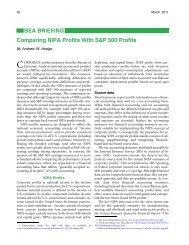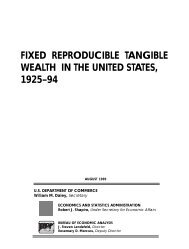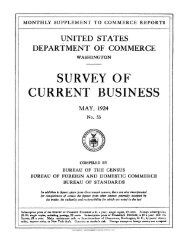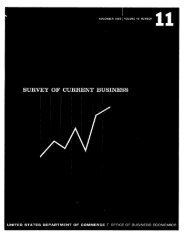current business statistics - Bureau of Economic Analysis
current business statistics - Bureau of Economic Analysis
current business statistics - Bureau of Economic Analysis
You also want an ePaper? Increase the reach of your titles
YUMPU automatically turns print PDFs into web optimized ePapers that Google loves.
February 1972 SURVEY OF CURRENT BUSINESS 21<br />
states caused by mounting costs, and<br />
(2) a series <strong>of</strong> reforms in the public<br />
assistance system. The reforms, which<br />
will lower grants in fiscal 1973, include:<br />
(1) the implementation <strong>of</strong> new regulations<br />
defining reimbursable costs and<br />
improved accounting systems, (2) improved<br />
control and management <strong>of</strong> state<br />
payments systems, and (3) proposed<br />
legislation emphasizing greater cost effectiveness.<br />
It is also expected that<br />
higher social security benefits and the<br />
extension <strong>of</strong> medicare benefits to the<br />
disabled will lower public assistance<br />
payments.<br />
Education grants (excluding special<br />
revenue sharing) are projected to advance<br />
about $K billion in 1973, to a<br />
total <strong>of</strong> more than $4 billion. Most <strong>of</strong><br />
this advance is in emergency school<br />
assistance to aid State and local governments<br />
in meeting the problems <strong>of</strong><br />
desegregation and "racially impacted"<br />
school districts. Grants for higher education<br />
activities are expected to decline,<br />
but are being supplanted by transfers<br />
and loans.<br />
The budget once again includes the<br />
administration's proposal for general<br />
revenue sharing effective in early 1972,<br />
retroactive to January. The proposal<br />
would boost grants $2% billion in fiscal<br />
1972 and $5 billion in 1973. In addition,<br />
special revenue sharing is proposed for<br />
six broad-purpose programs—education,<br />
law enforcement, manpower training,<br />
transportation, rural development,<br />
and urban community development.<br />
The effective date for two <strong>of</strong> these<br />
programs—education and urban development—would<br />
be July 1, 1972, adding<br />
more than $% billion to 1973 grants.<br />
The remaining increase in grants for<br />
1973, about $2K billion altogether, is<br />
spread among a wide variety <strong>of</strong> programs,<br />
principally for environmental<br />
protection, model cities, and emergency<br />
employment assistance. Grants under<br />
the latter program, which was initiated<br />
in fiscal 1972, amount to over $% billion<br />
this year and are estimated to increase<br />
to more than $1 billion in fiscal<br />
1973. Highway grants are expected to<br />
increase about $% billion in 1973 to<br />
$4.8 billion.<br />
Large deficits increase interest payments<br />
Net interest paid is projected to increase<br />
nearly $1% billion in 1973 compared<br />
to an estimated decline <strong>of</strong> over<br />
$% billion in the <strong>current</strong> fiscal year.<br />
This large increase is primarily the result<br />
<strong>of</strong> large budget deficits. The new<br />
budget estimates that debt held by the<br />
public (including the Federal Reserve<br />
System) will increase $39%• billion in<br />
fiscal 1972 and $27% billion in 1973,<br />
compared to an increase <strong>of</strong> slightly<br />
less than $19% billion in fiscal 1971.<br />
Subsidies (less the <strong>current</strong> surplus<br />
<strong>of</strong> government enterprises) are expected<br />
to increase over $% billion in 1973. Payments<br />
to farmers would increase about<br />
$1 billion. Partly <strong>of</strong>fsetting this advance<br />
is a smaller deficit for the new Postal<br />
System—about $1 billion as compared<br />
to over $1% billion in the <strong>current</strong> year.<br />
Postal rate increases, effective January<br />
1973, would more than <strong>of</strong>fset pay raises<br />
for Postal workers scheduled in July<br />
1972 and January 1973. Housing subsidies<br />
are expected to increase $% billion.<br />
Budget-NIA Reconciliation<br />
The differences between the unified<br />
budget and the NIA Federal sector can<br />
be summarized in the following major<br />
categories: (1) coverage; (2) the treatment<br />
<strong>of</strong> financial transactions; (3) net-<br />
Table 8.—Relationship <strong>of</strong> Federal Government<br />
Receipts and Expenditures in the<br />
National Income Accounts to the Unified<br />
Budget, Fiscal Years 1971-73<br />
Receipts<br />
Unified budget receipts<br />
Coverage differences<br />
Netting and grossing<br />
Timing differences<br />
M iscellaneous<br />
Federal receipts, NIA basis<br />
Expenditures<br />
Unified budget outlays<br />
Coverage differences<br />
Financial transactions<br />
Net purchases <strong>of</strong> land<br />
Netting and grossing<br />
Timing differences<br />
Miscellaneous<br />
[Billions <strong>of</strong> dollars]<br />
Federal expenditures, NIA basis..<br />
1971<br />
188.4<br />
4.6<br />
1.1<br />
—.1<br />
194.0<br />
211.4<br />
—.5<br />
-3.4<br />
.7<br />
4.6<br />
—.7<br />
.3<br />
212 .4<br />
1972<br />
197.8<br />
—.1<br />
4.7 4<br />
—.1<br />
202.8<br />
236.6<br />
-.5<br />
-3.1<br />
.4<br />
4.7<br />
—.7<br />
.4<br />
237.8<br />
1973<br />
220 8<br />
— 2<br />
5.2<br />
2 5<br />
-.3<br />
227.9<br />
246.3<br />
.5<br />
-1.3<br />
1.7<br />
5.2<br />
3.0<br />
.5<br />
255.9<br />
Sources: Estimates by the Office <strong>of</strong> Management and<br />
Budget and BEA.<br />
ting and grossing; (4) timing; (5) land<br />
transactions; and (6) miscellaneous.<br />
Table 8 shows a summary reconciliation<br />
<strong>of</strong> Federal receipts and outlays as<br />
recorded in the unified budget and in<br />
the national income accounts.<br />
Coverage<br />
The unified budget includes receipts<br />
and expenditures associated with various<br />
territories and possessions—such<br />
as the Virgin Islands, Puerto Rico, and<br />
Guam—that are excluded from the NIA<br />
Federal sector. An adjustment is made<br />
to both receipts and expenditures for<br />
these transactions. Adjustment is also<br />
made for various deposit fund transactions<br />
which are excluded from the<br />
budget but included in the NIA<br />
measure. In recent years, the major deposit<br />
fund adjustment has involved<br />
royalties received from Louisiana <strong>of</strong>fshore<br />
oil leases. Because <strong>of</strong> a dispute<br />
over the ownership <strong>of</strong> these royalties,<br />
the Federal Government put the annual<br />
payments in an escrow account. A<br />
recent Supreme Court order awarded<br />
over $1 billion <strong>of</strong> these funds to the<br />
Federal Government, and the unified<br />
budget records the transfer as an <strong>of</strong>fset<br />
to 1973 expenditures. However, over<br />
the years, the NIA has recorded the annual'royalty<br />
payments as <strong>business</strong> nontax<br />
receipts, necessitating an adjustment<br />
from the budget basis to the NIA<br />
basis. In 1973, an adjustment is<br />
necessary in order to <strong>of</strong>fset the negative<br />
impact <strong>of</strong> these payments on budget<br />
expenditures.<br />
Financial transactions<br />
Most Federal loans are included in<br />
unified budget outlays in a seperate<br />
"loan account." In addition, the budget<br />
records most foreign loans and those<br />
domestic loans whose repayment is contingent<br />
rather than mandatory in the<br />
"expenditure account." The NIA excludes<br />
all loans except most CCC pricesupport<br />
loans, which are recorded as<br />
Federal purchases and as a part <strong>of</strong><br />
farm income. Loan transactions excluded<br />
from the NIA but included in the<br />
unified budget are estimated to be over<br />
$1# billion in 1973. Also in the category<br />
<strong>of</strong> financial transactions is an adjust-<br />
(Continued on page 28)







